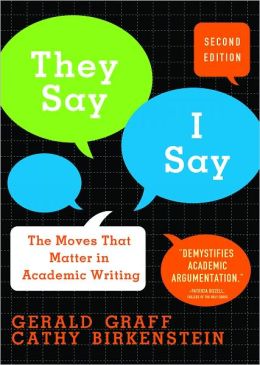
Critique of “They Say I Say”
I choose this sample from Graff Birkenstein’s “They Say I Say”. Graff Birkenstein is a professor of English and Education at the University of Illinois at Chicago. This sample is reading material from my class “Introduction to Rhetoric and Writing Studies.” It is also an academic essay about educating people on how to compose academic writing. I used two quotations from this essay to prove that it uses plain style language and to argue that this plain language can benefit students. Some people might say that this kind of essay should be written in the official style since it is an academic essay (and it is attempting to teach academic writing), but this sample is a great example proving that good academic writing can be written in plain language. In my opinion, we need to change the perception that academic writing must be official. I think what makes an essay “good” isn’t whether or not it is official or plain, but rather that it allows the reader to benefit and learn something from it.
“Think about an activity that you do particularly well: cooking, playing the piano, shooting a basketball, even something as basic as driving a car. If you reflect on this activity, you'll realize that once you mastered it you no longer had to give much conscious thought to the various moves that go into doing it. Performing this activity, in other words, depends on your having learned a series of complicated moves-moves that may seem mysterious or difficult to those who haven't yet learned them” (1).
“The same applies to writing. Often without consciously realizing it, accomplished writers routinely rely on a stock of established moves that are crucial for communicating sophisticated ideas. What makes writers masters of their trade is not only their ability to express interesting thoughts, but their mastery of an inventory of basic moves that they probably picked up by reading a wide range of other accomplished writers. Less experienced writers, by contrast, are often unfamiliar with these basic moves, and unsure how to make them in their own writing. This book is intended as a short, user-friendly guide to the basic moves of academic writing” (1).
Let us look at the readability values about this sample first, its Average Grade Level is 13.1. For an academic essay, 13.1 is fairly low. The Syllables per Word of this sample is 1.6, the Words per Sentence is 24.0, and the Flesch-Kincaid Reading Ease is 46.3. All of these values indicate that this sample is written in plain language.
Let’s look at the sentence dynamic. First of all, the word choice of this sample are short and common words such as “cooking”, “communicating”, “unfamiliar” and so on. At the same time, it avoids legal, foreign, and technical jargon. Furthermore, there are no abbreviations in the two paragraphs. In addition, these two quotations are written in short sentences with simple structure instead of various subordinate clauses. The shortest sentence is the first sentence in the second paragraph, “The same applies to writing.” It only contains five words. Moreover, it keeps the subject, verb, and object close together. Also, in the first paragraph, the writer uses very simple examples like “cooking”, “playing the piano”, “shooting a basketball” and “driving a car.” These simple examples can help readers to understand what the writer wants to express. These two paragraphs I chose are written in plain language, and use the exemplum strategy. It shows that when we learn how to write well, just like our other skills such as cooking or driving a car, we can eventually master it.
To sum up, all the values and sentence dynamics reflect that this sample is written in plain language, and the readers this essay targets are normal people who want to learn how to compose an academic essay or students who study a related major and need to know how to write theoretically. Some people may think that this essay being written in plain language would influence its authority, and that readers may question whether the writer is professional or not. However, in my opinion, I think the writer’s use of plain language is a wise decision. This essay’s target readers are those people or students who have interest in academic writing, which means they lack of the knowledge of how to write professionally. Thus, the purpose of this essay is to educate people how to write academically. If the writer used official style, it would be hard for readers to understand, not mention to learn from it. Worse, readers might lose their interest in the beginning of the essay if this essay was written in official style. People can benefit from plain language; it will be easier for them to learn how to write academic papers. I, for instance, as an international student, can read this essay without looking for the definition of each word, and I can understand what the writer is talking about. I can read this essay smoothly without stopping to think “what is the meaning of this sentence?” Therefore, I think using plain language will help the public to be educated by this kind of article. In other words, the public can more easily learn something from it. This academic article shows us that official style is not a necessary component of academic writing.
Xiaoqian Zeng
Reference
Graff, G., & Birkenstein, Cathy. (2010). They say / I say : The moves that matter in academic writing / Gerald Graff, Cathy Birkenstein. (2nd ed.). New York: W.W. Norton &.

No comments:
Post a Comment